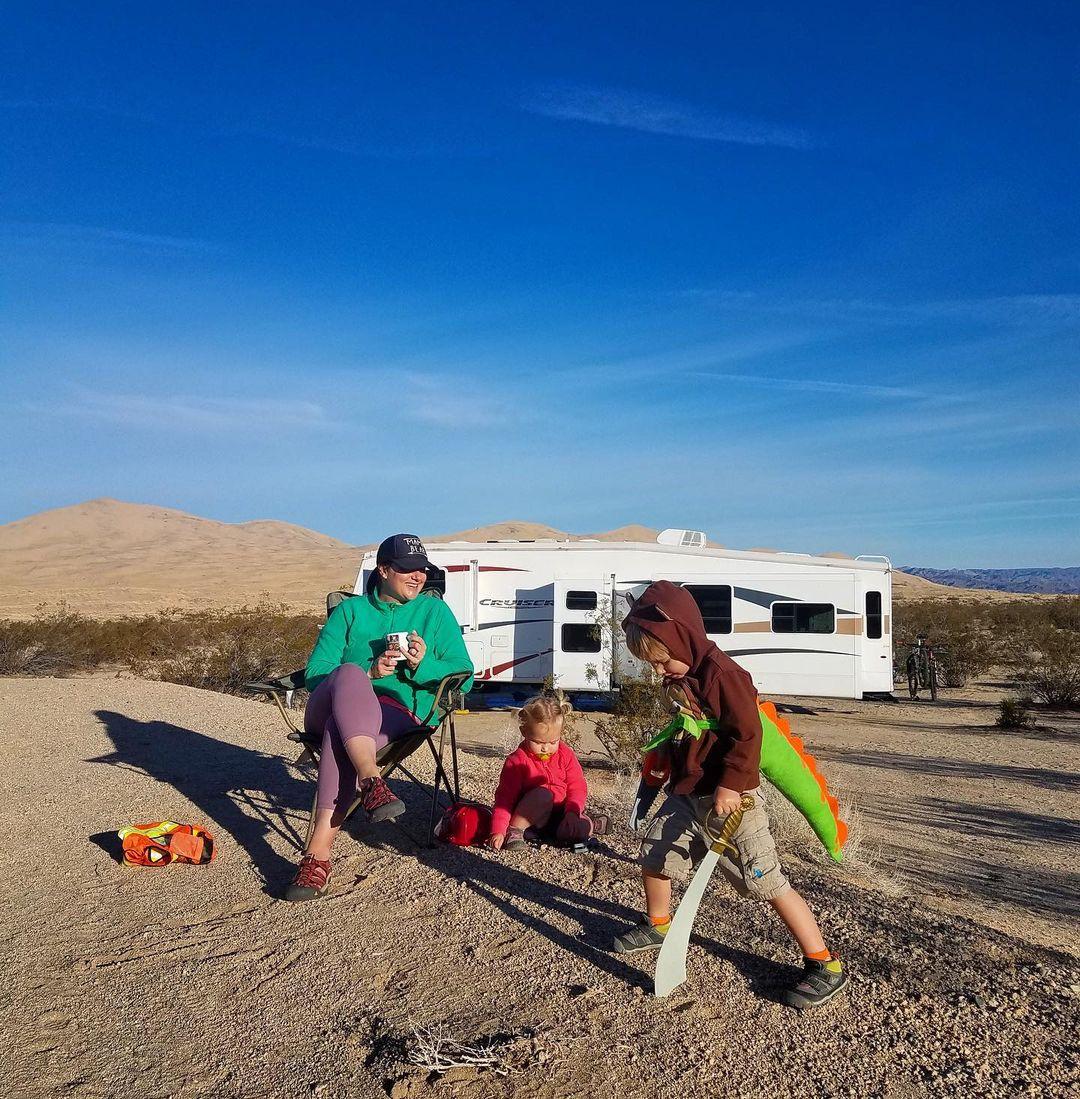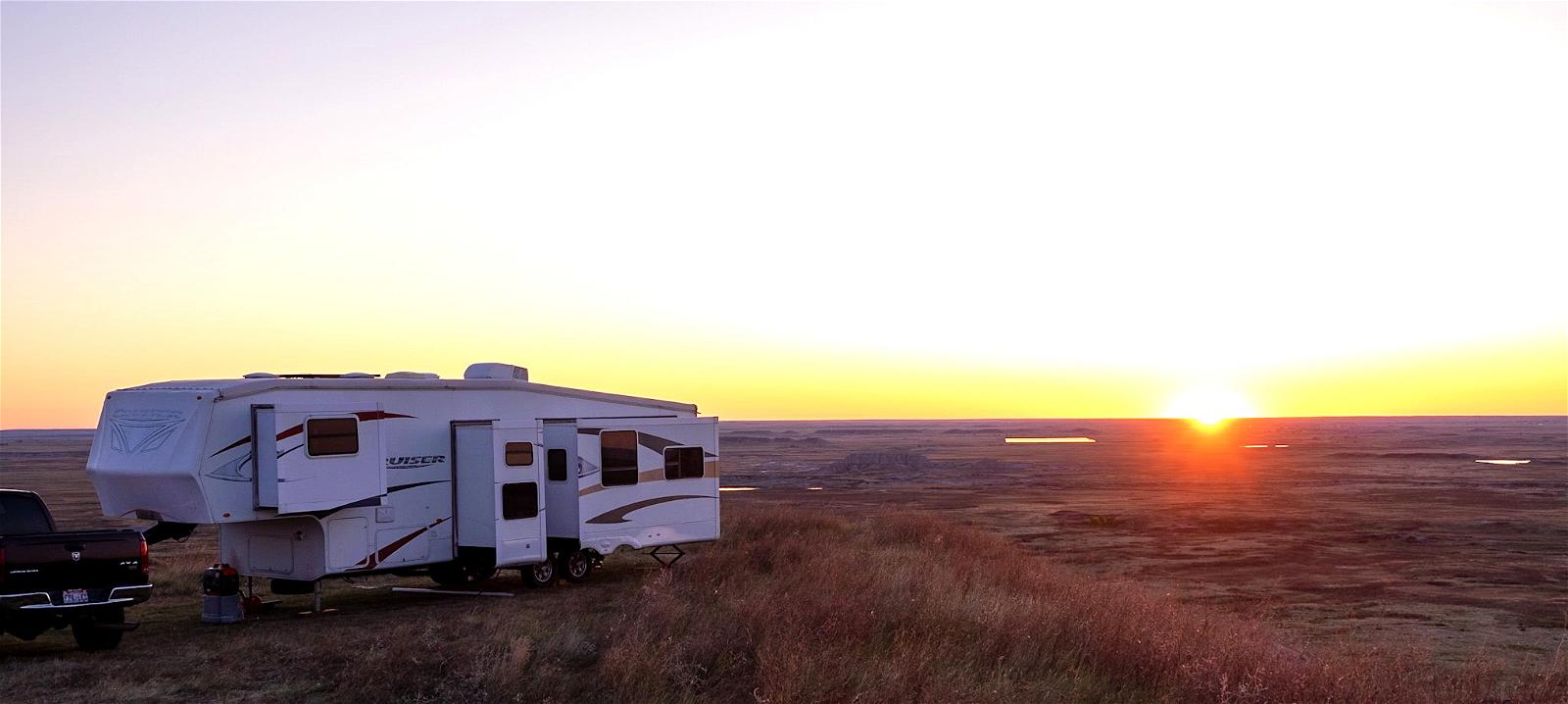


The boundless bakers family boondocking in the badlands of South Dakota
The great thing about RVing is the opportunity it gives you to get away from it all. Boondocking off the beaten path is a chance to experience nature and spend time with family and friends without the distractions of everyday life. But do you know what the best part is? In an RV, you’re still able to enjoy some of the luxuries in life while being out in the middle of nowhere!
While tent camping is all about roughing it, RVing is about being in the great outdoors while still having a bathroom, running water, lights, the ability to charge devices, and maybe even a TV for movie night. RV camping is the best of all worlds! But if you’re not hooked up, how do you enjoy the finer things in life? Is it possible to dry camp and still be able to utilize your RV’s features? It sure is!
The secret to a functional RV while boondocking is a great battery. So, what is the best RV battery for dry camping? Well, in order to answer that, you’ll have to know a few things about your power needs, available space, and budget. Let’s talk briefly about how to answer these questions for yourself and then get into the specific types of batteries that may be a good fit for your boondocking needs.
Step one is having a basic understanding of your RV power system. RVs come with two types of electrical systems, DC/12V and AC/120V. AC power is what is available in the majority of houses, and DC power comes from batteries. Your cell phone is the perfect example to look at. When you are at home, you plug your phone into an AC outlet that looks like any standard power outlet. When you are in the car, you have either a phone charger that plugs into your 12V charger socket or a USB plug. In the car, these options run off of the DC power supplied by your vehicle’s battery.
Here are some examples of the different devices that run off of AC and DC power:
AC Powered |
DC Powered |
| Microwave | Interior and exterior lighting |
| Coffee Maker | Power awnings |
| Blender | Slide outs |
| TV and video games | Landing gear and leveling systems |
| Computers | Water pump |
| Space heaters | Pump for heater |
| Dehumidifiers | Propane gas detector |
| Hot water heater (can also run on propane) | Some TVs |
| Refrigerator (can also run on propane) | RV Stereo |
| Electric vents and fans | |
| Control panel, battery monitors |
When you are hooked up at an RV park, the majority of electric devices in your RV are going to be running off of AC power from the park. Any DC devices will pull power from the battery, which is then replenished by the AC current, by way of a converter.
When your RV is unplugged, the only power supply is the DC power that is stored in your battery bank. In order to power the entire RV from your battery bank, there are a couple of key aspects you will need to account for:
To help decide which type of battery is best for you, you need to understand your power needs. If you plan on using more than just the basics, such as lights and water pump, you’ll want to estimate what devices you will use on a daily basis, and for how long. Once you have this information, you can check the device for the amount of watts or amps it uses. If the device has information on amps, perfect. If it has watts, you’ll need to convert that to amps.
Watts = Volts x Amps
To find the amps that a device uses, you will take the watt rating and divide it by volts (120 for AC power). You will then need to multiply amps by 10 to convert from 120V/AC to 12V/DC power. Here is a common example:
Laptop uses 45W on AC/120V. So 45 / 120 = 0.375. So on AC/120V power, the charger uses 0.375 amps per hour. Since you will be powering everything from DC/12V power while boondocking, you will need to convert it from 120V to 12V by multiplying by 10. So 0.375*10=3.75 amps per hour on 12V/DC power. If you charge your laptop for 5 hours on average a day, you will need 18.75 Ah (5*3.75) just for charging your laptop.
There are some great calculators online to help with this, like this one. This calculator keeps the math to a minimum and has some benchmark numbers for common devices. Once you have an idea of how many amp hours you need, you can then start building your battery bank.
Instead of having one battery to run DC power in an RV, a battery bank is multiple batteries that are wired together to create a bank to store energy. Basically, you’re connecting batteries to increase your power and bandwidth.
Batteries can be connected together in either “series” or “parallel”. Parallel keeps the voltage the same, and increases the Ah. Series will increase the voltage and keep the Ah the same.

Sunset while dry camping at Badlands, South Dakota
Now that you know how much power you need for boondocking, you are ready to choose the batteries to make up your battery bank. When selecting batteries, you will need to make a decision about:
As mentioned, RV DC runs on 12V. Because of that, 12V batteries are the most straightforward approach when it comes to upgrading your battery. Other options include 6V and 24V. 6V batteries are generally cheaper, but you’ll need more for sufficient power. This is going to take up more space and make for additional weight. A 24V battery can be a great option as it saves on space, but you will need a step-down converter.
Amp hours or Ah are what electronic devices consume when in use. Most RV batteries are sized between 50 and 200 Ah. Again, you’ll want to determine how much power you need while boondocking to make the best decision on what type of Ah you’ll need with your battery bank.
The type of batteries used in the RV battery bank is probably the most important decision to make regarding off-grid power. This will impact how many discharges the batteries can take, the capacity, the weight and space the battery bank takes up, how closely the bank will need to be monitored, and whether or not they need to be in a vented area.
Lead-acid batteries are most common and generally come with a new RV. They are similar to a vehicle battery. These batteries use plates immersed in a liquid electrolyte solution that is a combination of sulfuric acid and water. Lead-acid batteries come in both 6V and 12V.
Being the most common type of RV battery, they are also the most inexpensive. They can be a good option for weekend campers who plan on running a generator multiple times a day. They can be a hassle in the long run as they require a consistent level of water to keep the plates submerged. Another downside is they are recommended to only be discharged to 45%, meaning if you have an 80 Ah battery, you can really only use about 36 Ah. And lastly, flooded lead-acid batteries tend to be heavy and require ventilation.
Sealed lead-acid batteries are similar to flooded lead-acid batteries. They come in AGM (absorbed glass mat) or gel. The most significant advantage in sealed vs. flooded is they discharge slightly better. It is recommended not to discharge more than 50-75%. They are also easier to manage as they don’t require maintenance like the flooded batteries. While sealed batteries do have pros over flooded, they are higher in cost and are still just as heavy. The higher price point might not be worth the slight advantage.
The newest type of battery available for RVs is lithium. Lithium batteries have quickly become the preferred battery type for several reasons. They are lighter than traditional batteries, about half the weight to be exact. With RVing, weight is very important. They are ideal for use with solar panels. If you are boondocking for extended periods, getting set up with solar is a great way to go. Lithium RV batteries are super safe and require no maintenance, thanks to their LiFePO4 technology. And, maybe the best thing about these batteries? They are more powerful and last up to 4x longer than other batteries! Lithium batteries store energy longer, and you’re able to discharge to 80%.
So then what’s the downside to lithium? The one thing to think about is cost. Lithium-ion batteries run at a higher price point than other batteries, but in the long run, it’s safe to say they are totally worth it, especially when dry camping. Lithium batteries are going to last longer, provide more power, and make your life easier while enjoying the great outdoors.
Without a doubt lithium batteries are the best RV battery for boondocking. Here are a few options to choose from:
Since RVs come built with 12V, it’s the easiest way to go when upgrading to a new lithium battery. The 12V 100AH is going to be a drop-in replacement for AGM and most lead-acid batteries. 100 amp hours of capacity is going to give you plenty of power to get through a day of boondocking. Build up your battery bank with multiple 12V 100AH batteries for an even longer lasting power supply. Simply turn on your generator when it’s time to recharge. Or better yet, set up your rig with solar! These batteries are ideal for setting up with solar panels. This RV battery is backed up by a best in class 11 year warranty.
You can never be too prepared with dry camping, and that’s exactly what you’ll be with this RV battery. This battery is more energy dense than the 100AH, allowing you to go longer between charges. With a lifespan of 3,000 charge cycles, this battery will last up to 5 times longer than your typical SLA battery. If you plan on camping in extreme winter weather, this is the way to go. Again, as with all Dakota Lithium batteries, it comes with an 11 year warranty.
If you have a smaller rig, such as a van, this battery could be right for you. If your RV is less than 14 feet, this battery can power the lights, radio, small electronics such as your phone, and small fan. Easily link more batteries together in a series to create even more power! And with that 11 year warranty, you’ll have the peace of mind that your RV will stay powered no matter what.
Understanding how power works in your RV should make it simpler to choose the best RV battery for dry camping. You, as a camper, as well as your RV, have unique needs, so take the time to figure out what sort of power you need to ensure you get the best battery for you. If more energy, less charging, and peace of mind are what you’re looking for, lithium-ion is going to be your best bet. I recommend investing in your RV power now rather than wishing you had while you’re out trying to enjoy the incredible experience of boondocking.

The boundless baker family in northern Minnesota
About the author: Jessica Baker has been full-time RVing since 2018. She has traveled extensively throughout the U.S. and Canada in her fifth-wheel RV turned tiny home on wheels with her husband, two kids, and three cats. You can find out more about her travels at BoundlessBakers.com and follow along on her adventures on Instagram.